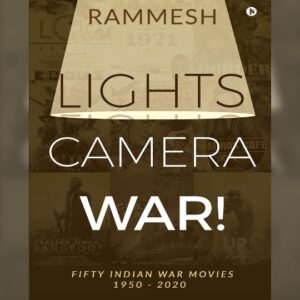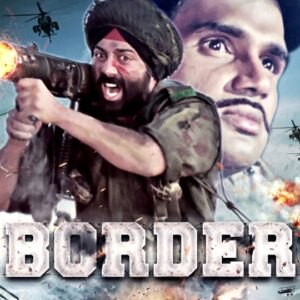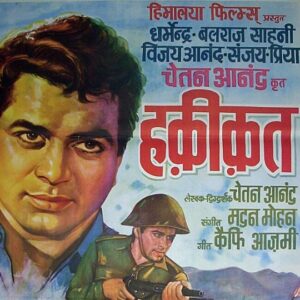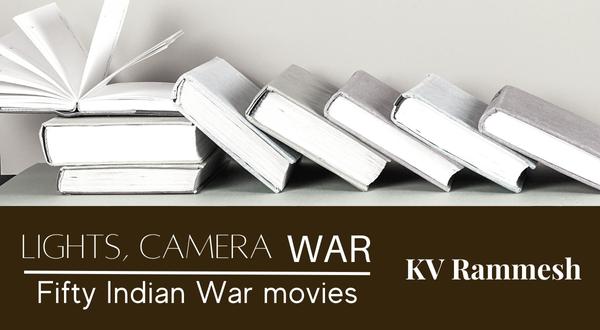Lights, Camera WAR! – KV Rammesh
KV Rammesh | kvr4060@gmail.com
“Fifty Indian War movies? You won’t find even fifteen.” That probably was the most insightful comment that I heard from many people with whom I shared the subject of my third book. Most of them told me sardonically “Tell me when the book is finished”. Another said “If you find fifty then…” a shrug and away he went. They were all absolutely correct – finding fifty Hindi films with war or military backgrounds especially set in the 20th century is a difficult task. Casting a wider net for films in all Indian languages ensured a wider choice from which I could trim down to 50. The seeds of the book were planted when I gave some inputs for an article published in ‘Outlook magazine’s special issue on the 50th anniversary of the 1965 war about Indian war films set in the 1965 Indo-Pak war of which I discovered there were none.
 My interest in war movies began in my childhood thanks to the wildly popular Commando comics, which were targeted obviously at schoolboys with tales of (mostly) British daring and cunning to defeat the “stupid” Germans and Japanese. The war movies that I saw were all from Hollywood and for a schoolboy, Clint Eastwood blasting hordes of Germans with an endless supply of bullets in Where Eagles Dare (1968) seemed to confirm every schoolboy’s idea of how wars were fought and won.
My interest in war movies began in my childhood thanks to the wildly popular Commando comics, which were targeted obviously at schoolboys with tales of (mostly) British daring and cunning to defeat the “stupid” Germans and Japanese. The war movies that I saw were all from Hollywood and for a schoolboy, Clint Eastwood blasting hordes of Germans with an endless supply of bullets in Where Eagles Dare (1968) seemed to confirm every schoolboy’s idea of how wars were fought and won.
A few years later, Hindustan ki Kasam (1973) was released. Swollen with pride at the Indian victory of 1971 and buoyed by the descriptions of the lightning war and a copious cache of news articles in my scrapbook, my then ambition to join the Indian Air Force was boosted by the sight of Indian Gnats chasing “Pakistani Sabres” on screen. Soon the joy gave way to a feeling of dejection as the on-screen heroics gave way to theatrics and finally melodrama; I and my school friends came out of the theater saying “What nonsense”. Growing up and watching the sporadic Indian war movie, that feeling of disappointment was confirmed time and again till 1982 when Govind Nihalani’s Vijeta was released on the IAF’s Golden Jubilee, which was a very authentic film on the IAF way of life.
So the question remains: Is there a truly good Indian war film? Yes, everyone will scream Border. One of the finest moments of the Indian Armed Forces was almost turned into a cinematic farce thanks to the ridiculous jingoism, bombastic dialogues, and persistent goof-ups in the film. The howls of protest about the “real events” came from those in the know – where was the Army AOP aircraft that kept circling as a FAC and guided the Hunters and Maruts to destroy the Pakistani tanks? Were there really that many Indian casualties as shown in the film? Was there really a BSF “Captain” who died as shown in the film?
The public enjoyed the cinematic bashing of arch-enemy Pakistan and Border was a bonafide hit, a rare achievement for a war film. At least four different film buffs told me, “Jumping from tank to tank and popping grenades down the hatches and nothing happens to Sunny Deol? Aren’t hatches closed from the inside?” That is a persistent comment on most Indian war films – why do they go haywire in the depiction of events? What’s on-screen – history? War fantasy? 
All of the above? None of the above? “Based on true events” has become a cinematic license to overdramatize events far beyond what really happened, a crime of which Hollywood is also guilty.
Since filmmakers are basically businessmen looking for a return on investment, the need to overdo patriotism to the point of jingoism is very common. The balance between entertainment, history, and patriotism is a tough call, and very rare is the film that gets all of them correct. Most of the time the pendulum keeps shifting from one corner to another and in most cases wildly so toward entertainment.
It is clear to most of us that the Indian cinematic treatment of war is somewhat reminiscent of the Commando comics – mostly one-dimensional and predictable. The reason is obvious – the Indian war film is box office poison.
Rachel Dwyer says, “War is not a topic which interests Indian film audiences who have little experience of it”. This is a very objective comment by one of the premier British experts on Hindi and South Asian cinema. She further states that though Hindi films largely cater to a “national” audience, the characters have typical Punjabi/North Indian surnames such as Khanna or Malhotra, a practice which spills over into war films too, making it all too clear that the target audience is the Northern Hindi speaking regions thus reducing the appeal of an “Indian” war film.
The best-ever Indian war film Haqeeqat wasn’t exactly a commercial success even though it was true to history and had some stunning songs, including the eternal “Ab tumhare hawale watan saathiyon”. More research gave the rather disappointing news – India’s role in the two World Wars and all post-independence wars is barely covered by the Indian film industry, which preferred to stick to its musical fantasies. It’s only in the 21st century that we can say that Indian cinema and mainstream “Bollywood” have come of age and have come out with some “war” films with varying degrees of box office success.

J.P. Dutta’s experience with LOC (2003) and Paltan (2018) only proved that the public and box office could be very fickle. If ‘Paltan‘ was a box office disaster, then Uri (2019) showed that “the josh” was very high among both viewers and politicians, as it painted a favorable picture of a “muscular government”, which “did something about cross border terrorism” thus becoming a monster hit. The writing is plain on the wall for everyone to see – you never know which war movie can click and for what reason.
Across India, the situation is no different in various film industries centered in Kolkata, Chennai, and Hyderabad, which are more comfortable churning out regular potboilers. The Malayalam film industry seems to have somehow stolen a lead in this area judging by the Major Mahadevan series of war films with the same character being played by the same actor, Mohanlal. However there too, fantasy prevails over reality. A wider trawl in other languages has been very disappointing but timely tips from various friends across India and overseas helped me to cast a wide net from which I could filter it down to the number that I wanted-50.
Since this book has the word “Indian” in it, the criteria for selection in this book have been based on the following “rules”:
- The wars covered are mostly from the 20th and 21st centuries fought by the Indian Armed Forces where men and women from different parts of India come together to fight for India (and not about ancient Empires fighting each other or even fantasy sagas like Bahubali, which almost everyone wanted me to include in this book).
- War is involved usually in the middle or final segment.
- War and its effects, or the military way of life occupy the full length of the film even though there may not be any war scenes.
Though this is not a complete list of all Indian war films, and there will be some glaring omissions, I hope that the reader will be able to enjoy the selections, get some new insights into India’s military history presented as small capsules to compare with the on-screen depiction of war, and hopefully take some of my irreverent comments in the right spirit.
While writing about the military, it is impossible not to run into various abbreviations and source notes. Those who wish to skip the bewildering array of abbreviations can refer to them in Appendix I. Appendix II covers the ranks of the Indian Armed Forces. Appendix III is about the gallantry awards in wartime and peacetime. The reference to various articles, sources, citations, and YouTube Links is in the NOTES section, which was available at that time.
The names of countries and some Indian cities used in the book are as current as the time of the events discussed. E.g. Burma for present-day Myanmar, Poona for present-day Pune, Bombay for Mumbai, Madras for Chennai, and so on. The references and comparisons to various Hollywood and other films are to show that sometimes the plots (and in some cases even the scenes) are copy-pasted while at other times serve as “inspiration”!
Last but not least. All the facts have been checked and any errors are entirely mine.
Have fun, read on, stay tuned, and click here to have the Book in your hand https://www.amazon.in/Lights-Camera-War-Indian-Movies/dp/1636335020
‘Only the dead have seen the end of war’ – Plato








Leave a Reply